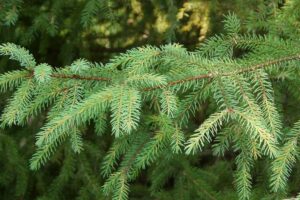
Black Spruce (Picea mariana) is a common small to medium-sized tree of coniferous bogs and other acidic swamps. The tree often grows in fire prone areas and is not very likely to survive a blaze. However, their seeds will survive, and heat will help release the seeds. In addition, the fire will reduce competition and make nutrients available to the seed bank.
The black spruce grows very slowly and is not an especially important tree from a commercial standpoint, because it does not obtain a large size and often grows in areas with limited access. Most cut Black Spruce will end up as pulpwood.
Black spruce has an interesting habit of growth in sphagnum bogs. The weight of the tree can actually push it down into the moss. When this happens the branches will take root, and can begin to take on the shape of a new tree. This same phenomenon can be caused by the weight of snow on the lower branches.
Native Americans made used Black Spruce for a number of things. The tree was used in medicine to aid in digestion, toothaches, kidney problems, etc. The roots were useful for weaving into baskets, and cordage. The pitch was used for sealing seams in birchbark canoes. The tree’s trunks made excellent tee-pee poles because they were very straight and had little taper. Branches and needles were used for mats and to make temporary shelters.
